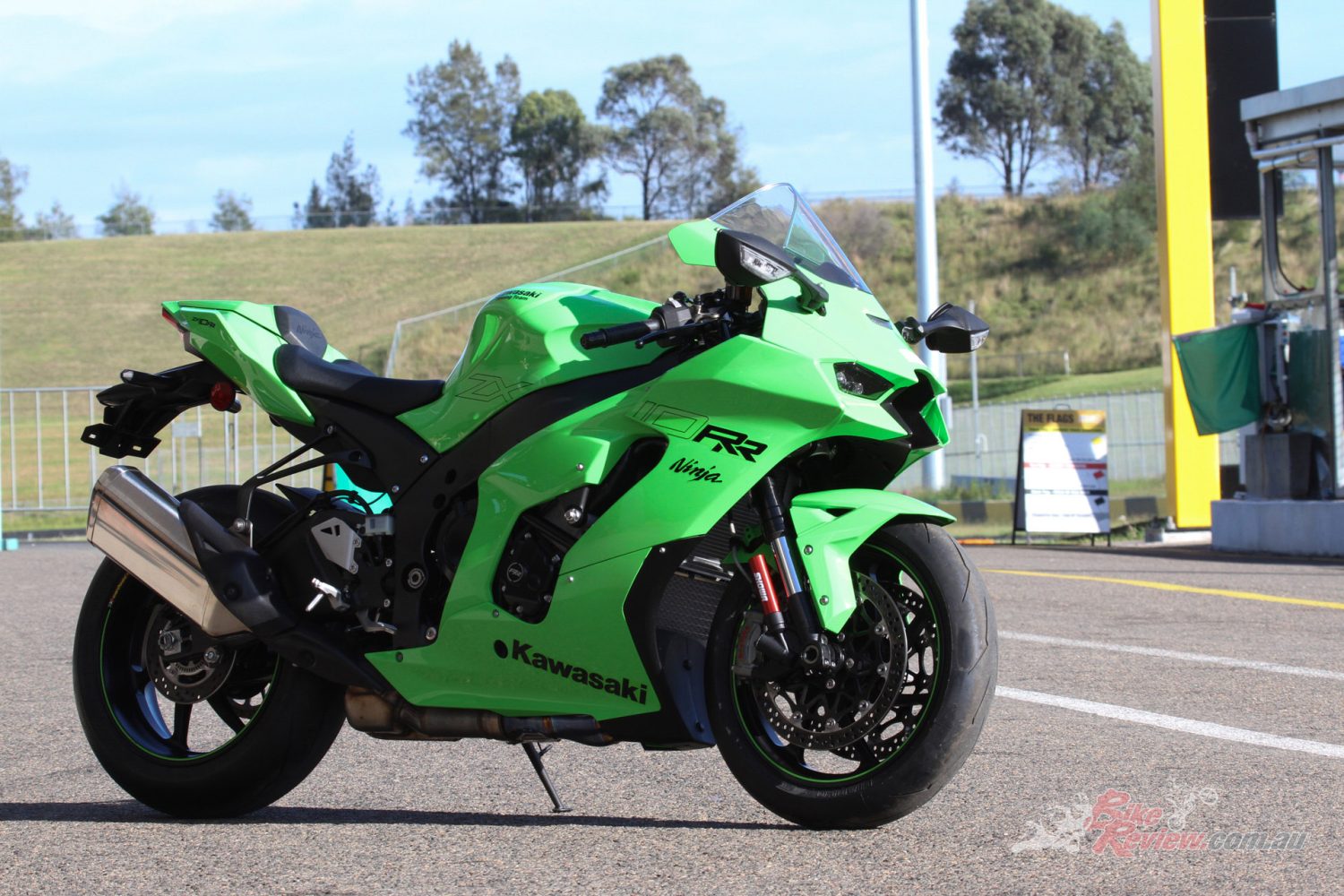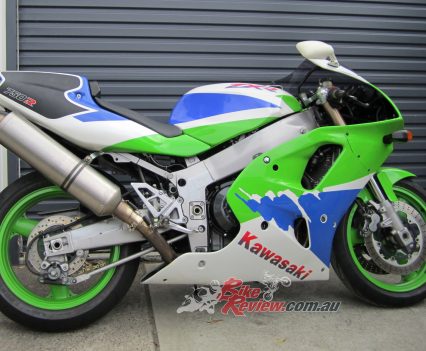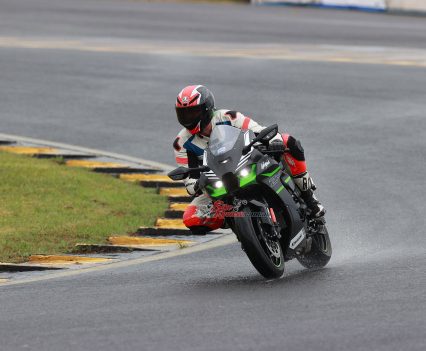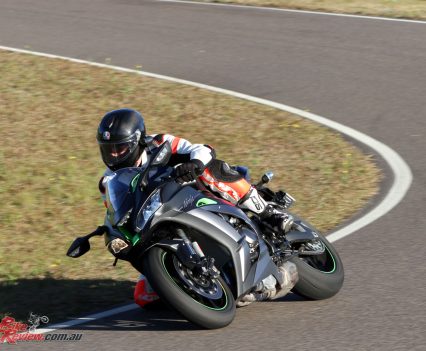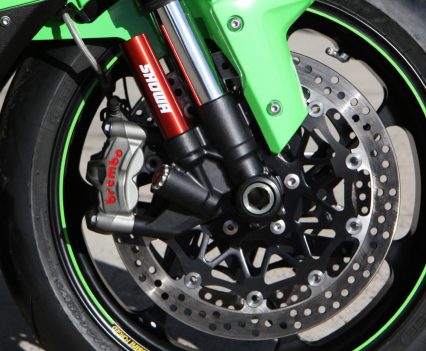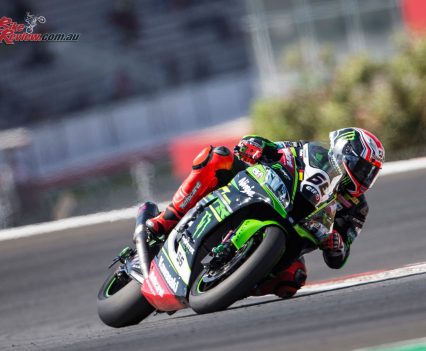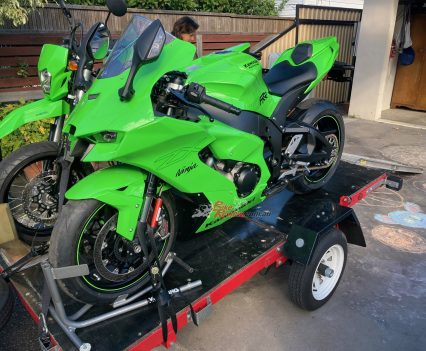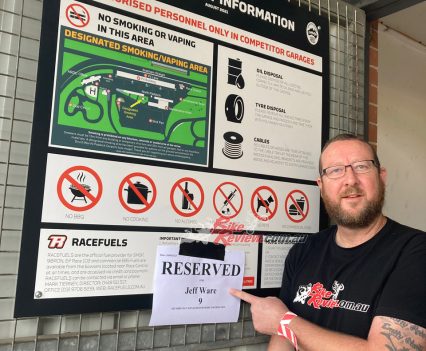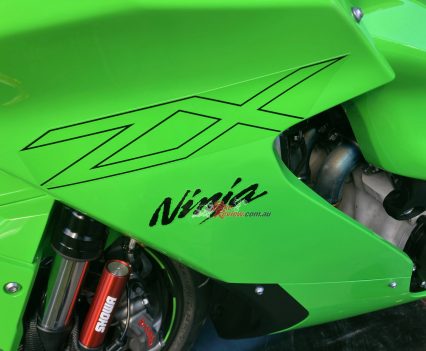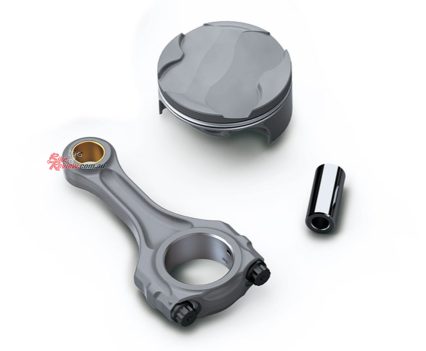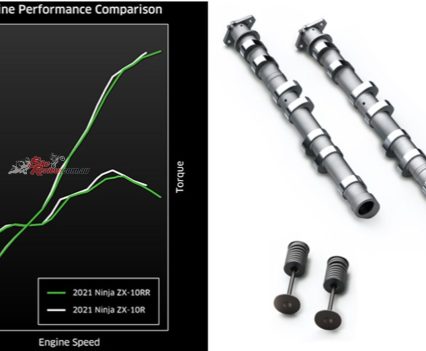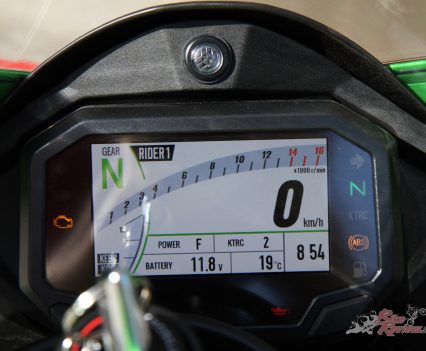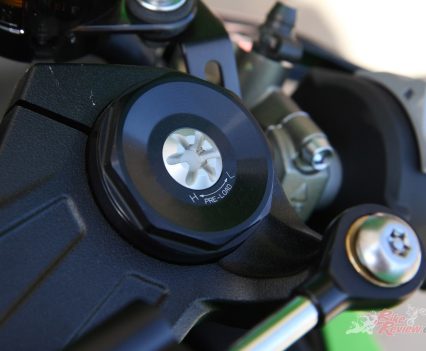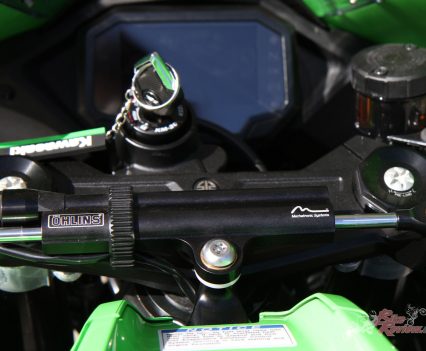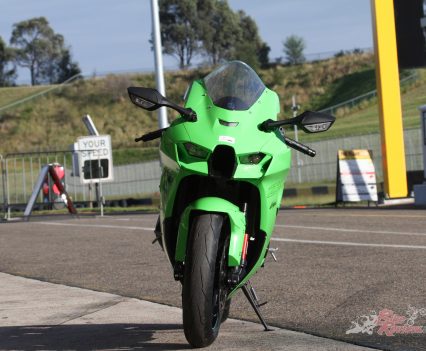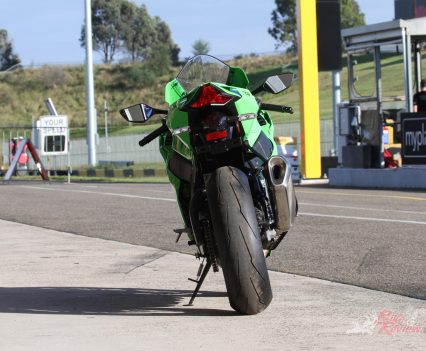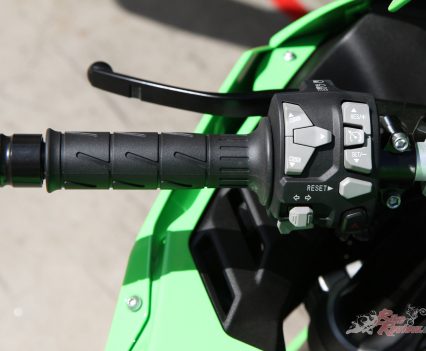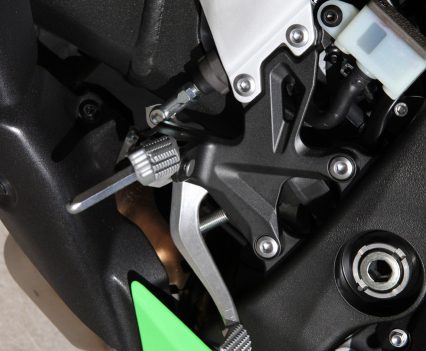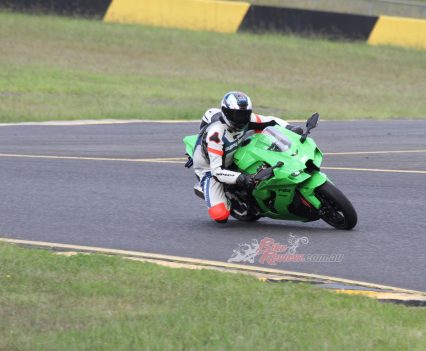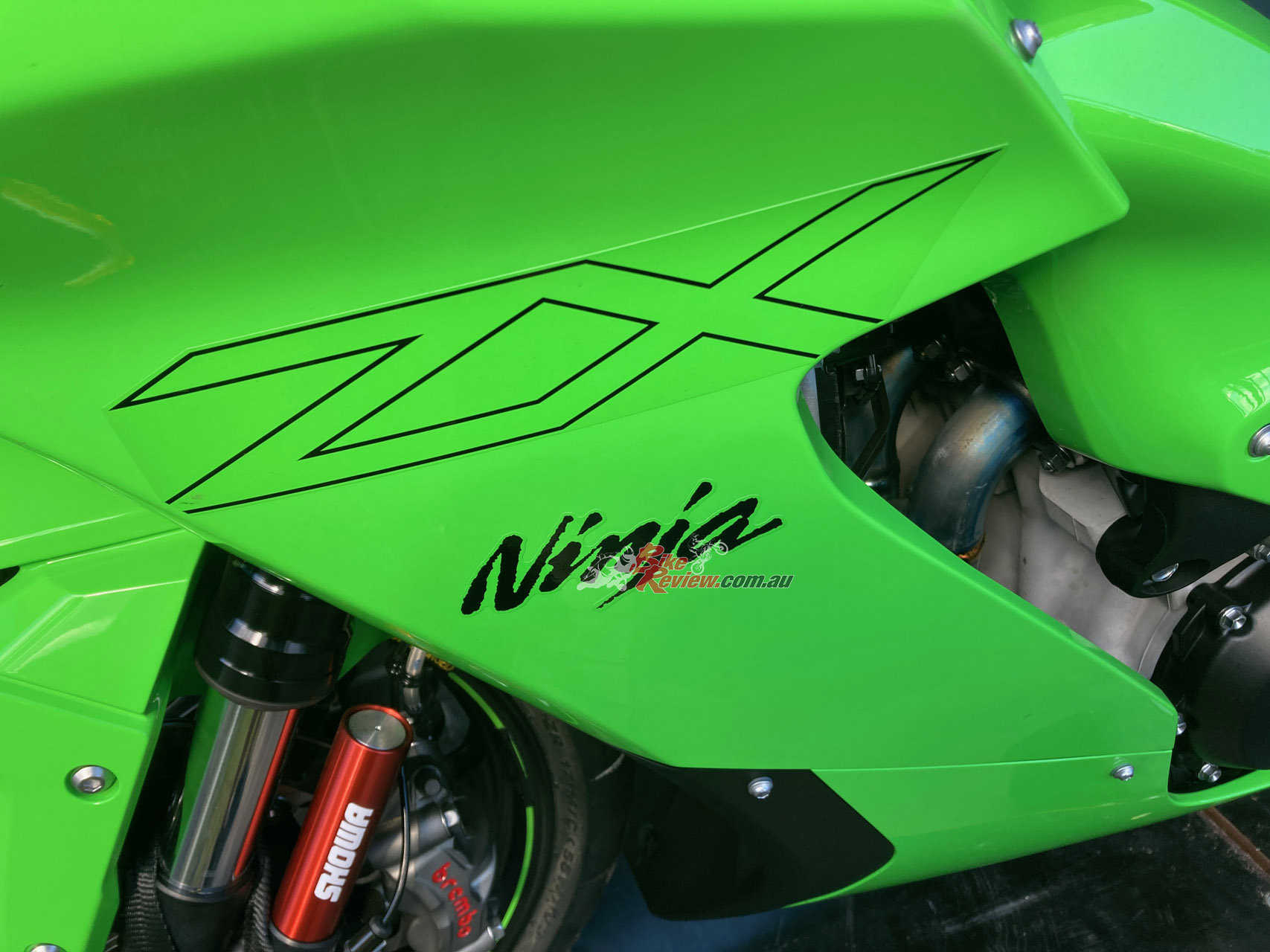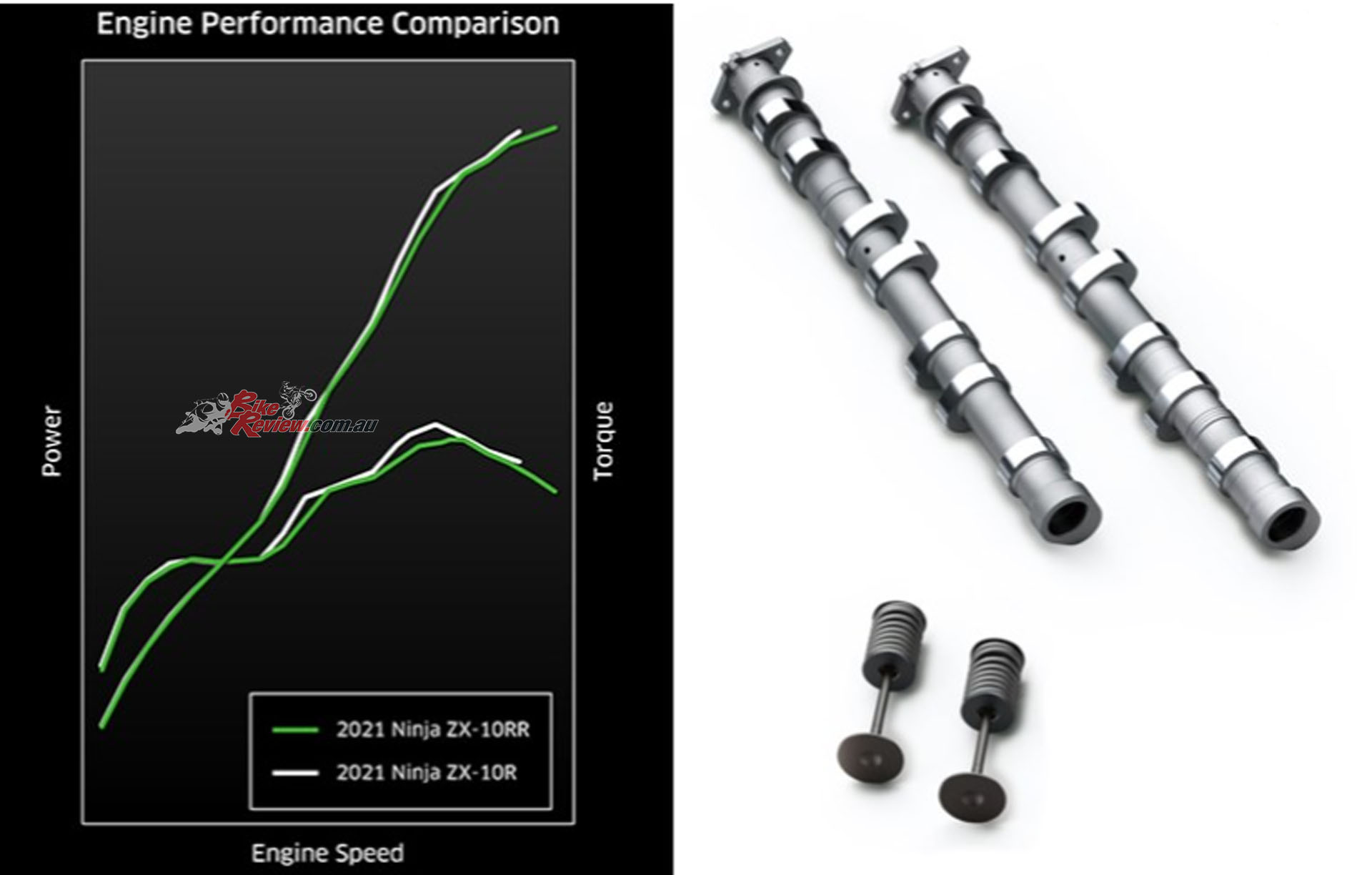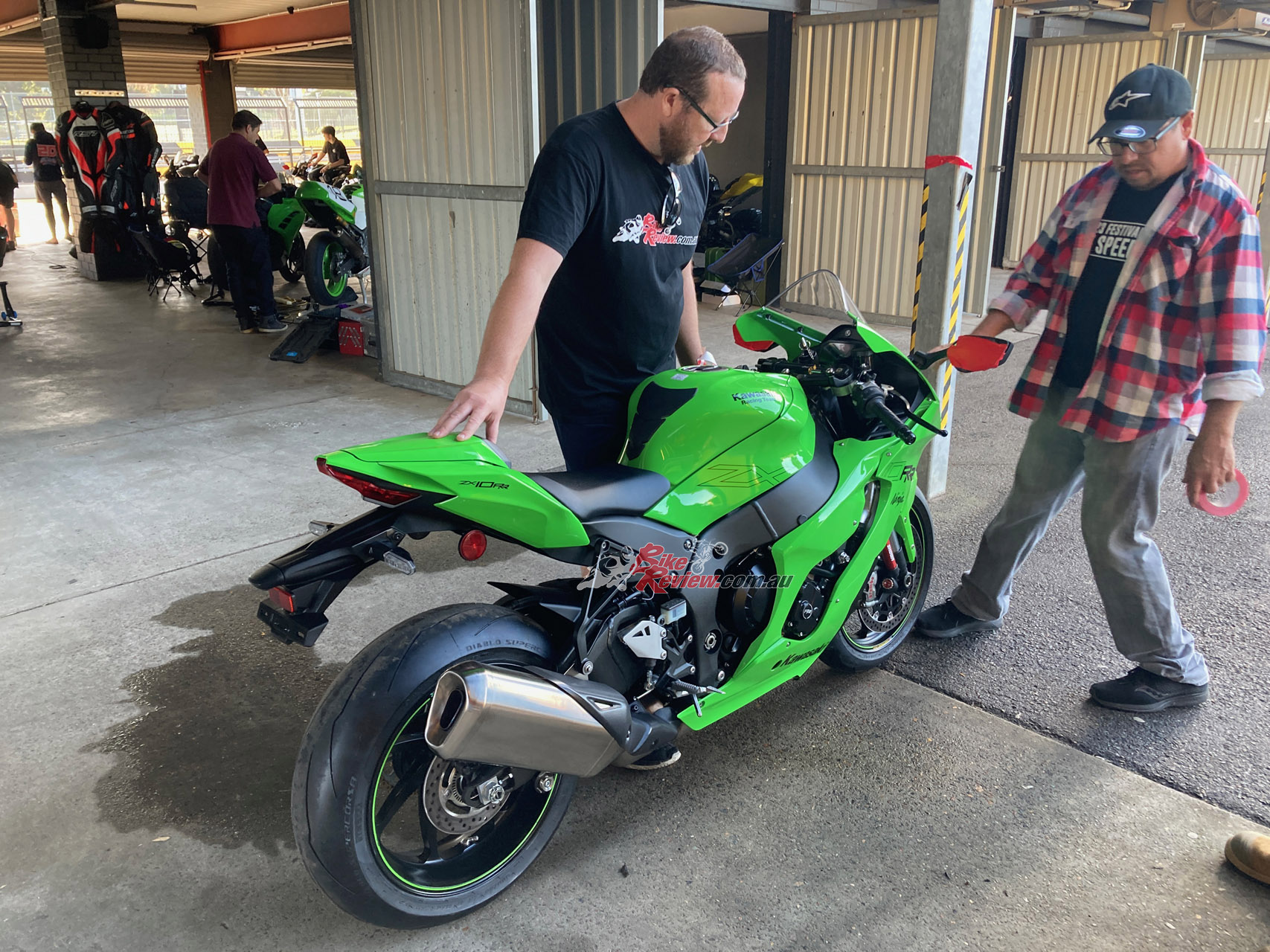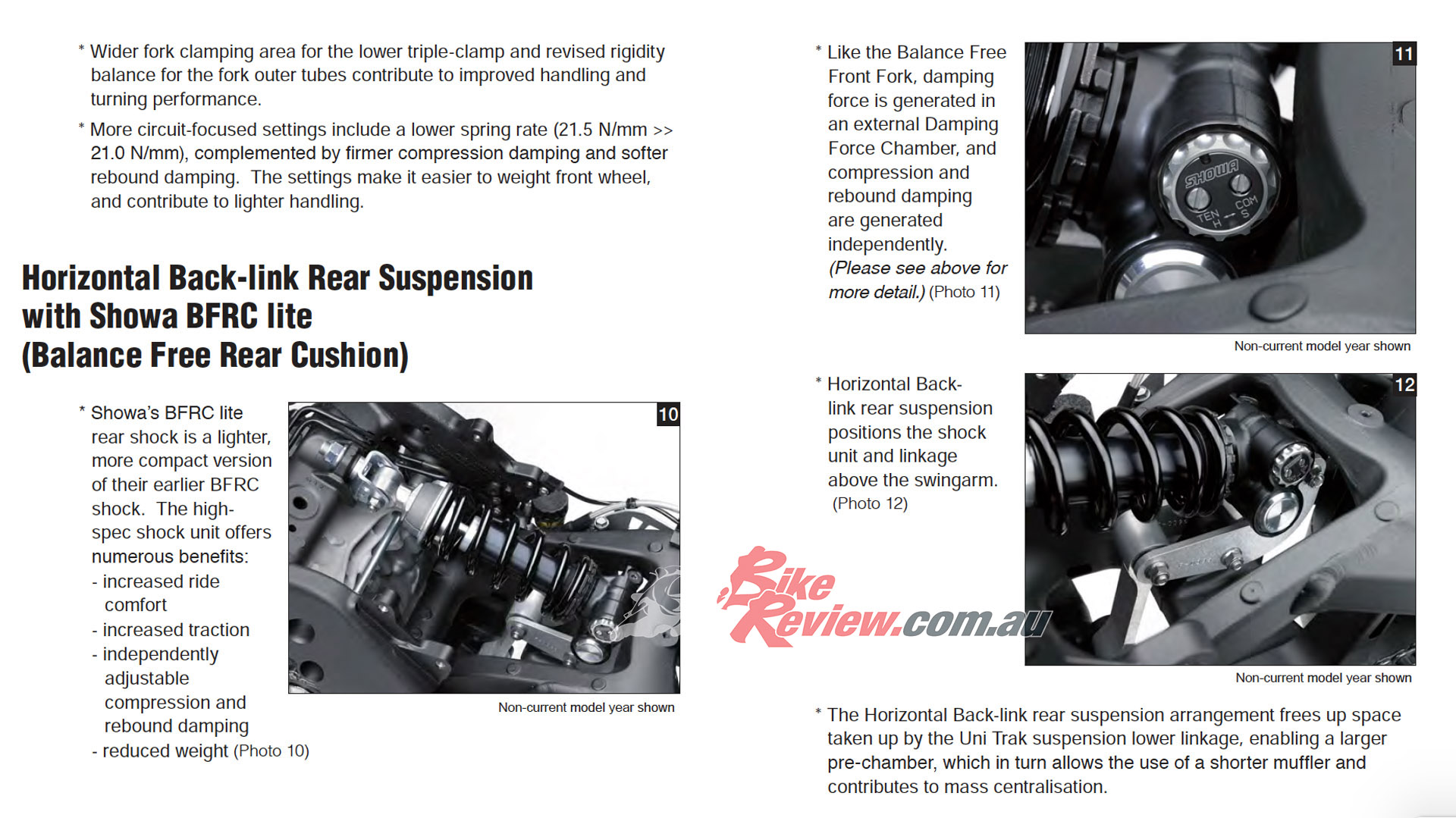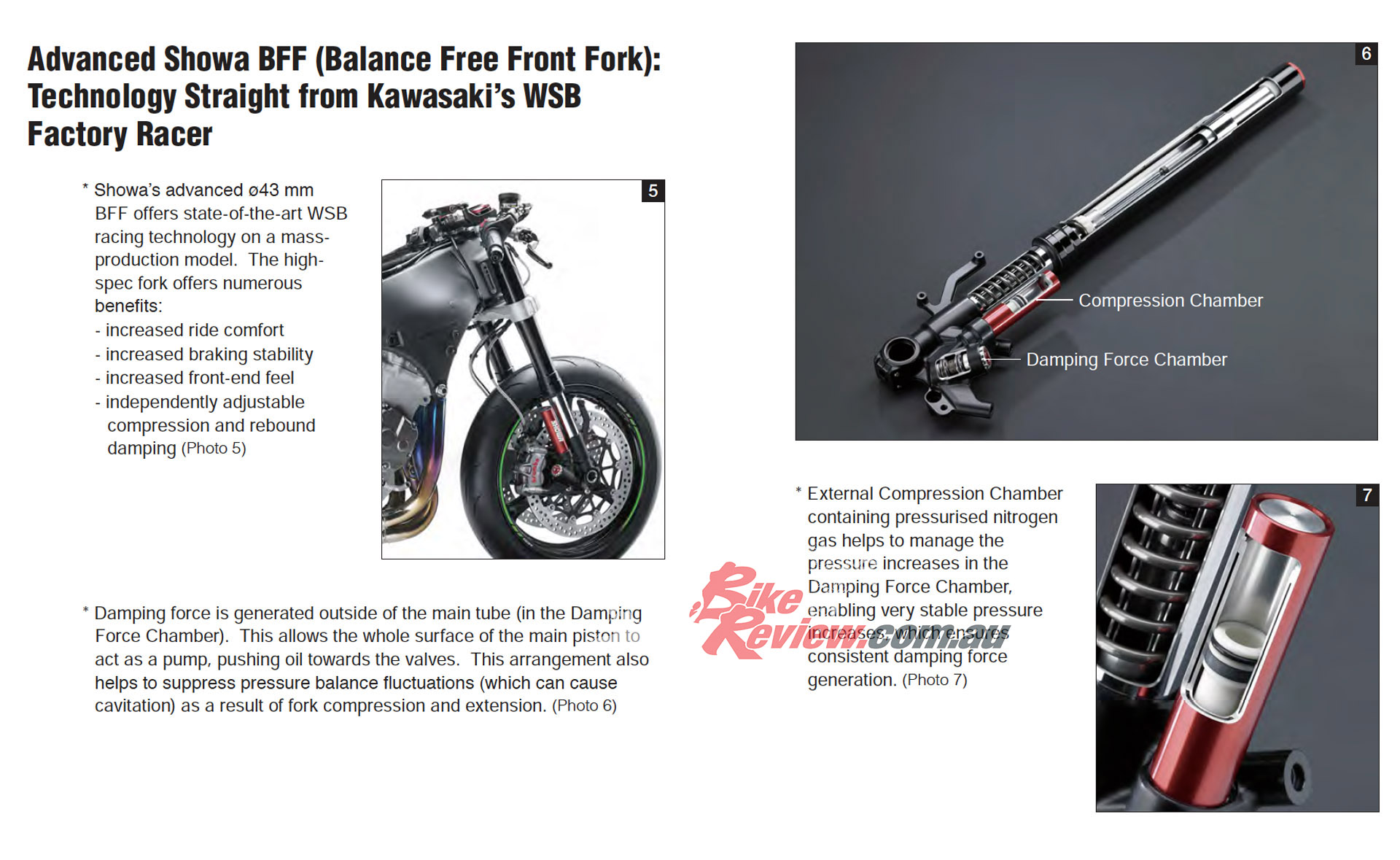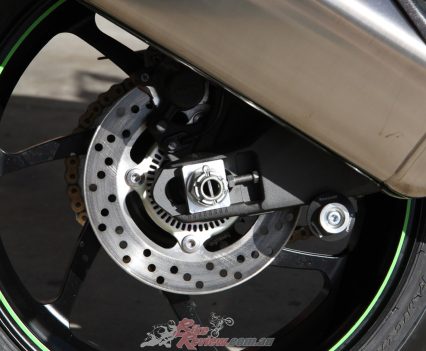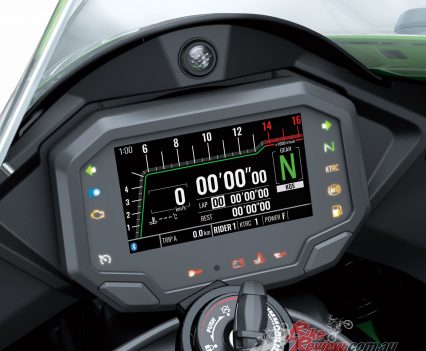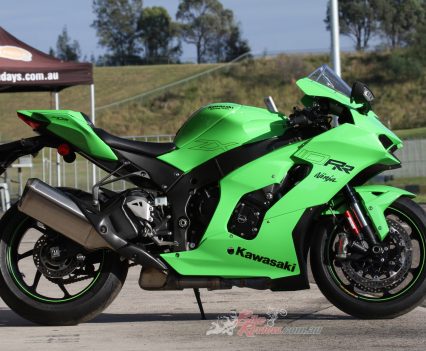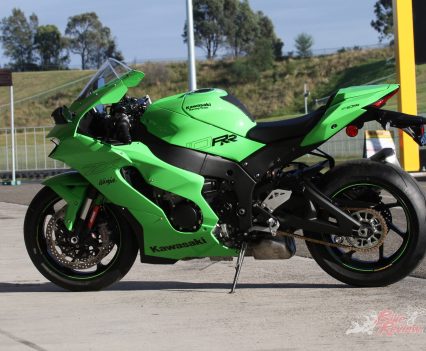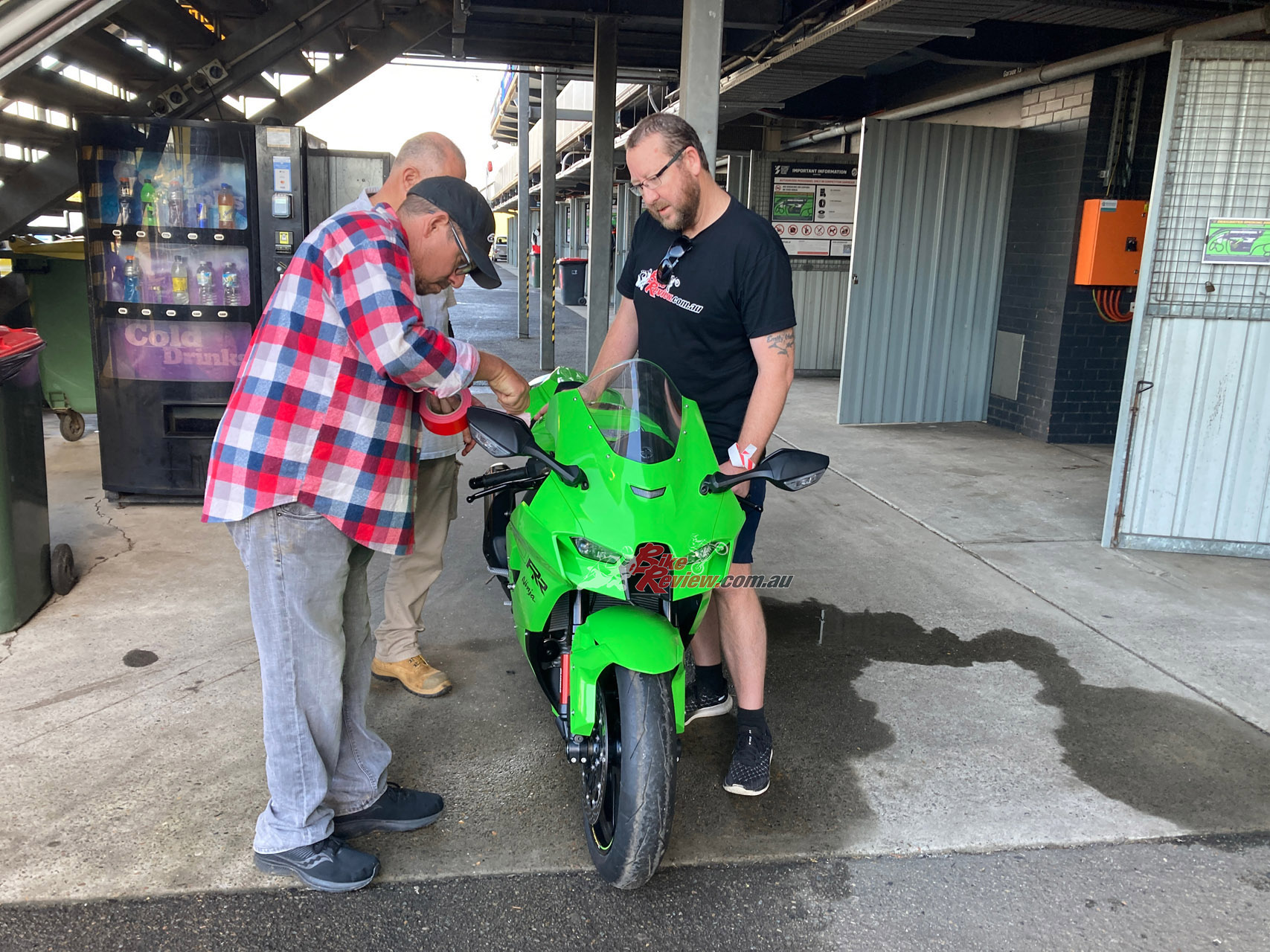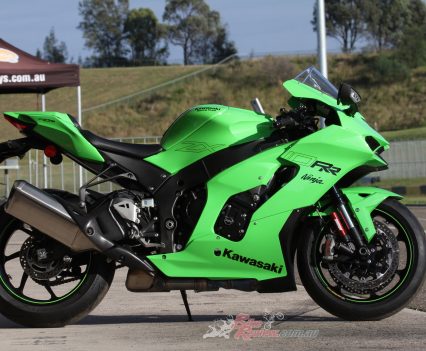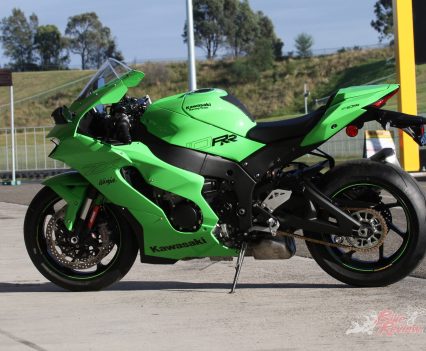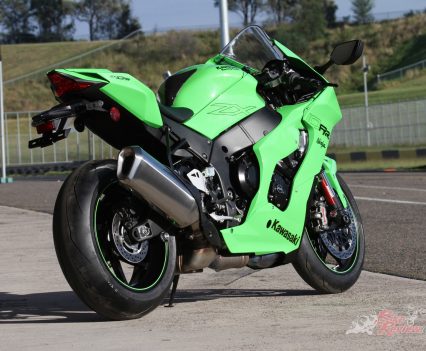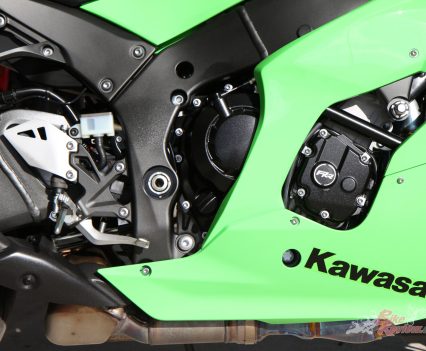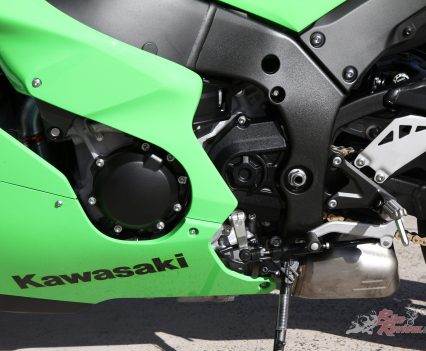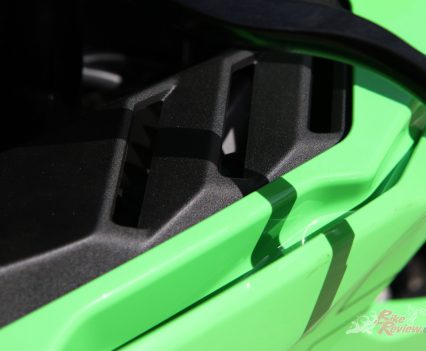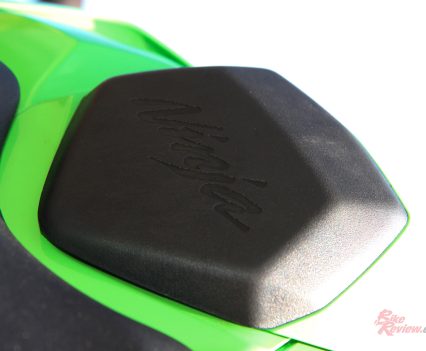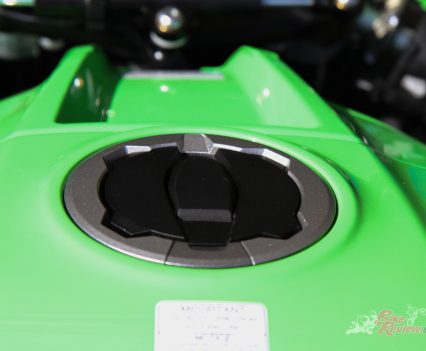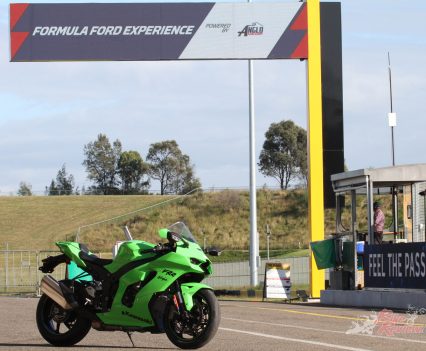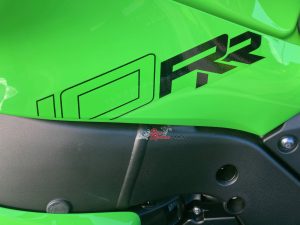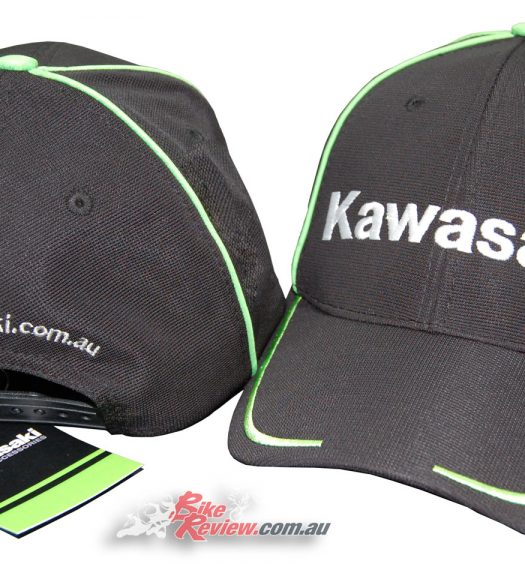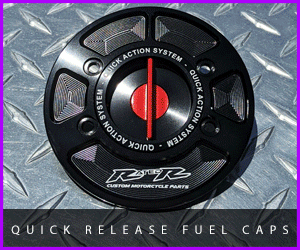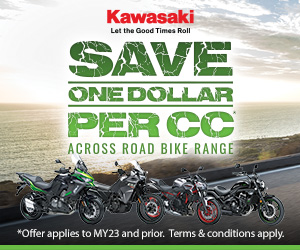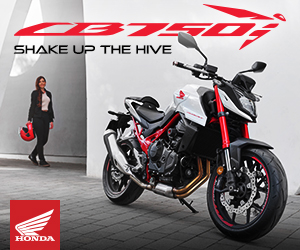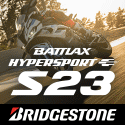The ZX-10RR is the closest Japanese OEM machine to a WorldSBK on the street. We put it to the test to find out the differences between the R and the RR... Photos: HMC Photography/SD Pics
Just over 10-months ago when we were first offered the chance to ride the Ninja ZX-10RR I was out of action with injuries. Now I’ve finally had a go on the special $42,379 + ORC one of only 500 globally model, and I wasn’t disappointed. The RR lived up to the hype. Here’s my test.
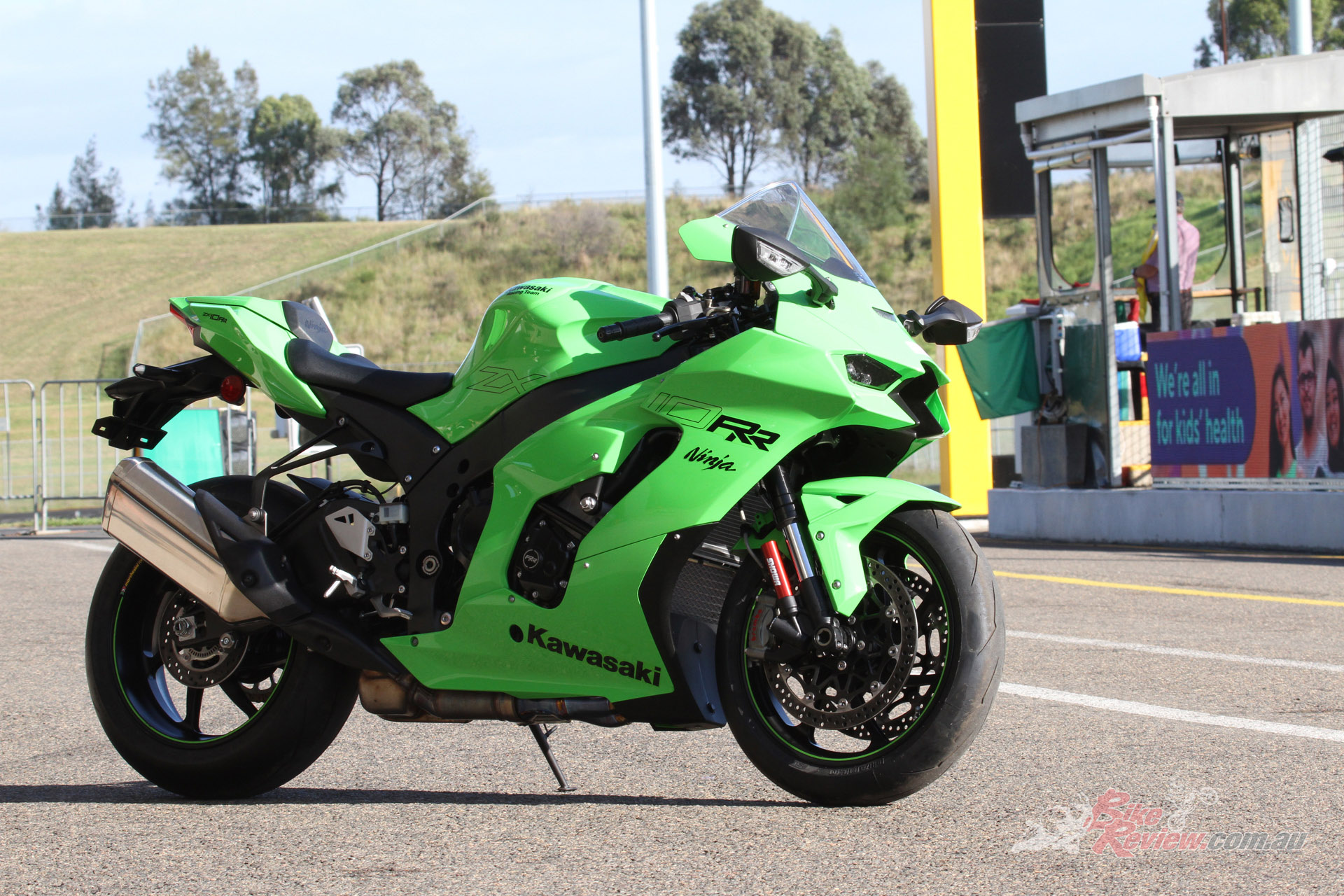
The ZX-10RR was released over a year ago but there are still a few around for those collectors out there…
Fast forward to April this year and the offer came back from KMA to take the RR to SMSP (Sydney Motorsports Park) for a day to test the beast. Having ridden every model ZX-10R since the very first one in 2004, as well as the 2011 Tom Sykes WorldSBK, Kevin Curtain ASBK factory bike and a few other racerbikes, the only one to tick off my Ninja list was the mighty RR model.
Having worked as an apprentice mechanic at a big and performance-based Kawasaki dealership in the early and mid 1990s, I was surrounded by ZXR750s, and occasionally the very rare ZXR750RR homologation special. I understand only around eight of these came in each year and only a handful were street bikes, the rest were in TKA (Team Kawasaki Australia) headed up by Peter Doyle.
With Mat Mladin, Aaron Slight, Rob Phillis, Marty Craggill and other legends winning just about everything there was to win, I was in awe of the RR models of the era… But I never rode one, despite the odd chance, it never happened…
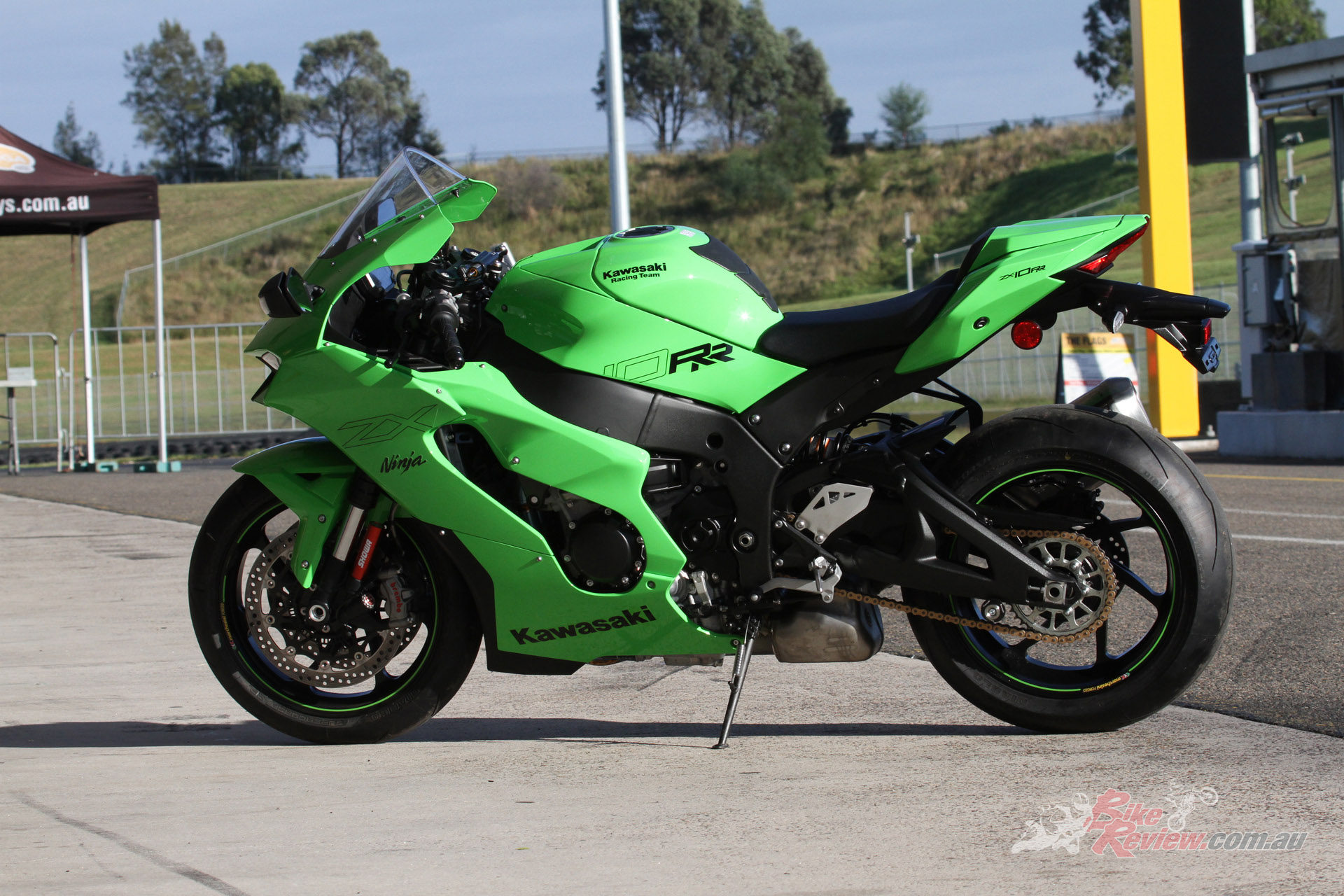
Marchesini forged alloy wheels, Brembo M50 calipers and 330mm rotors, single seat, hot motor… What a beast!
Two decades later our own Tim Holland got his hands on a nice ZXR750RR, 1993. He did a bit of a resto on it and left it at my place to tune for him. I did the valve clearances using race shims (half sizes), the carbies including balancing and jetting and a few other jobs, but I didn’t test ride it. Another opportunity missed. I should have, as he crashed it on the way home. It’ll be one of our Classic Motorcycle Mechanics magazine restorations next year.
I still remember as a young P plater hanging around Road Warriors Café in around 1993, when a person called Stuart Habblewaite showed up on a ZXR750RR. Oh my God! I could not believe my eyes. It was mid-week from memory, quiet, and the next minute Geoff Seddon was there too! He was doing a story on the bike for Streetbike Magazine… I would never have thought back then I would end up a bike journo too, let alone editor of Streebike just a decade later!
That memory is etched into my mind and as Heather and I load the ZX-10RR onto our trailer at KMA and I am feeling that same buzz I got back then when I saw an RR… When we arrive home, we look at the bike in the driveway, share a beer or six, and talk about the 1990s and how cool some of the sportsbikes and superbikes were and how awesome the RR looks.
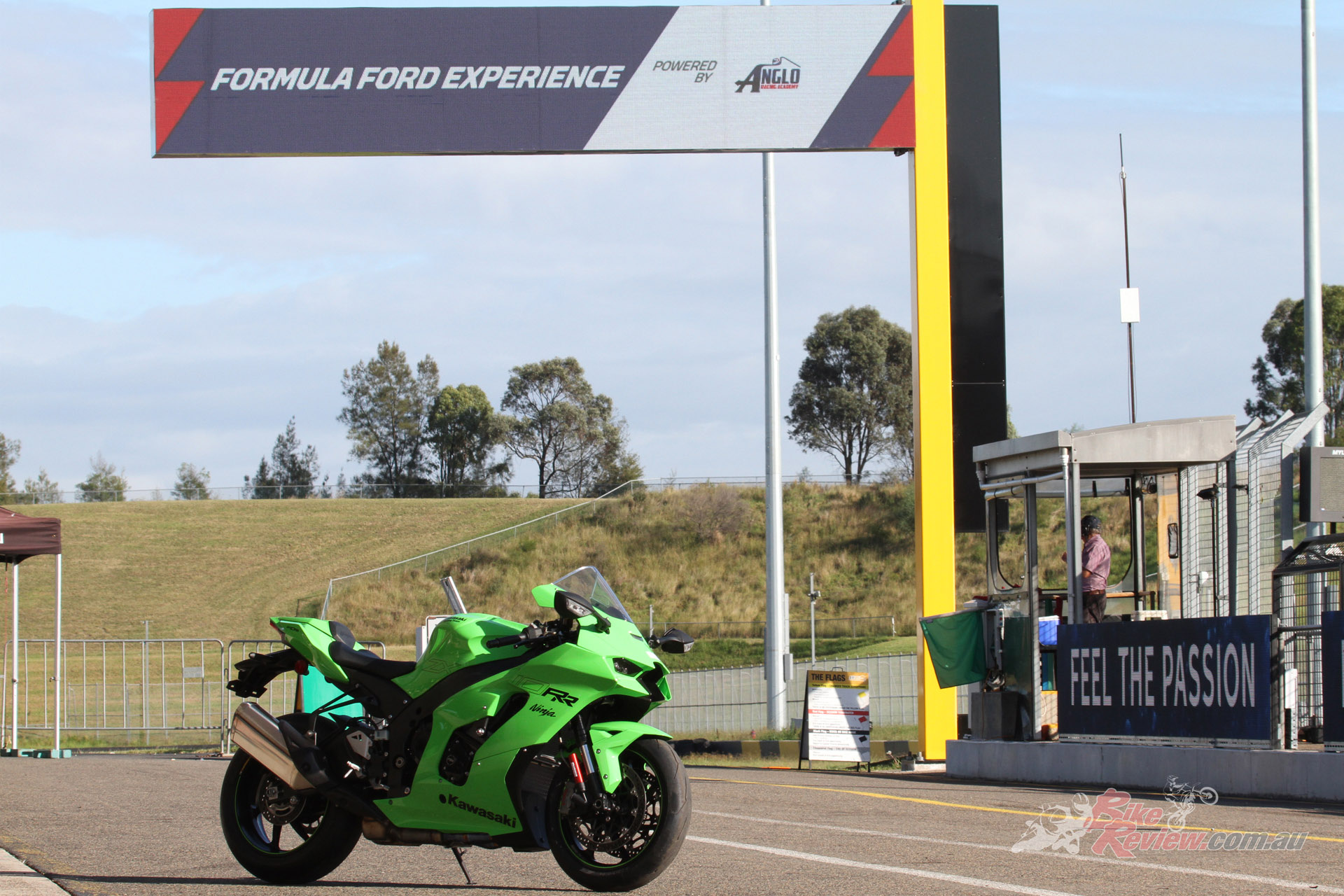
Jeff did plenty of laps of SMSP on the ZX-10RR and reckons it is one very refined track tool for the serious track rider…
I pack my track kit and after an unsettled night full of nerves and anticipation (first ride since hand injuries a year earlier, first time on a racetrack for 15-months, rare bike!), Heff and I head off to SMSP for the day. Oh, I had another 1000 to test as well, so 100 laps were planned (I do all groups BTB)…
Kawasaki provided a track kit for me for the day – race stands, tyre warmers, owner’s manual and I’d already been sent plenty of info on the bike. With lots of experience riding on track and street on the R version, I did not have too much to get up to speed with on the RR, but I knew the upgrades would make a significant difference to the machine, particularly the Marchesini wheels.
Firstly though, just looking at it tells me it means business. Single seat cowl, braided stainless-steel brake lines, forged aluminium Marchesini wheels… Pirelli DIABLO Supercorsa SP track day tyres and the trademark lime green that just takes me back to Aaron Slight, Rob Phillis, Akira Yanagawa, Hitoyasu Izutsu, Anthony Gobert and Scott Russell carving up the stage in WorldSBK…
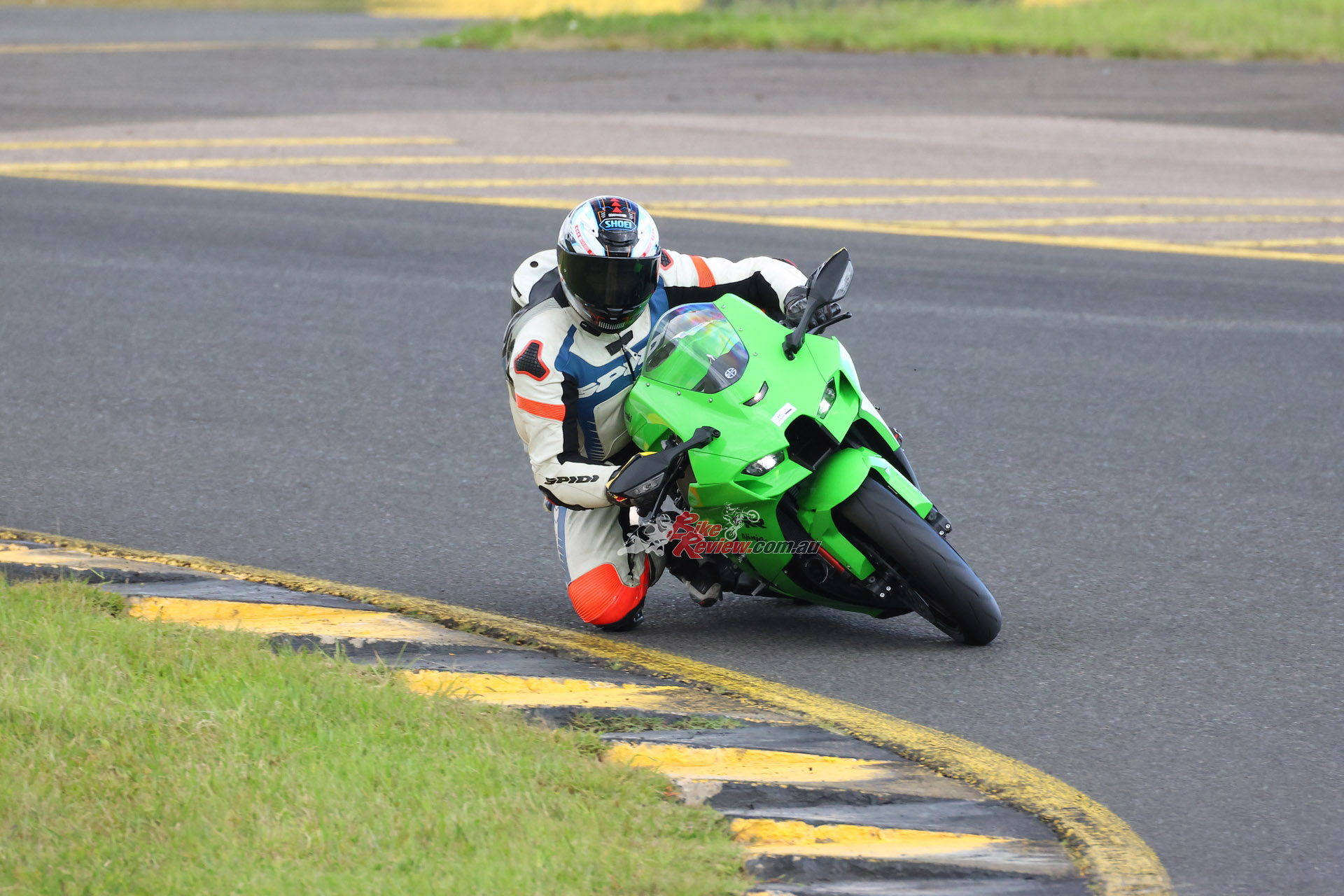
“At 207kg wet, the ZX-10RR feels very light and flickable, seat-of-the-pants estimate would be under 190kg”…
THE RIDE
Having already tested the standard ZX-10R and being very impressed with it, I was expecting big things of the ZX-10RR as I warmed it up for session one. Idling with a deep and aggressive menace, the green hulk sounds that extra bit edgy and tuned compared to the 10R, as it should with the racing goodies in the motor. Quick throttle blips have the muffled inline four’s tacho rapidly rising and falling. I fit my gloves, take the tyre warmers off, get the RR off the race stands and throw a leg over the bike.
With 14,000rpm to play with (800 more than the 10R) and 150kW on tap, I’m easing into things on the out lap. There are only 500 of these world-wide and I really want to hand this one back in the immaculate condition I picked it up in! At 207kg wet, the ZX-10RR feels very light and flickable, seat-of-the-pants estimate would be under 190kg (thanks no doubt to the forged alloy wheels offering light steering and flickability), it’s well balanced and lively.
With a 25-degree steering angle and 105mm of trail, the front-feels planted yet responsive as I warm up… and those whopping M50 Brembo calipers and 330mm rotors are nowhere near as savage as I expected. In fact, they are fantastic in initial bite and responsive in modulation.
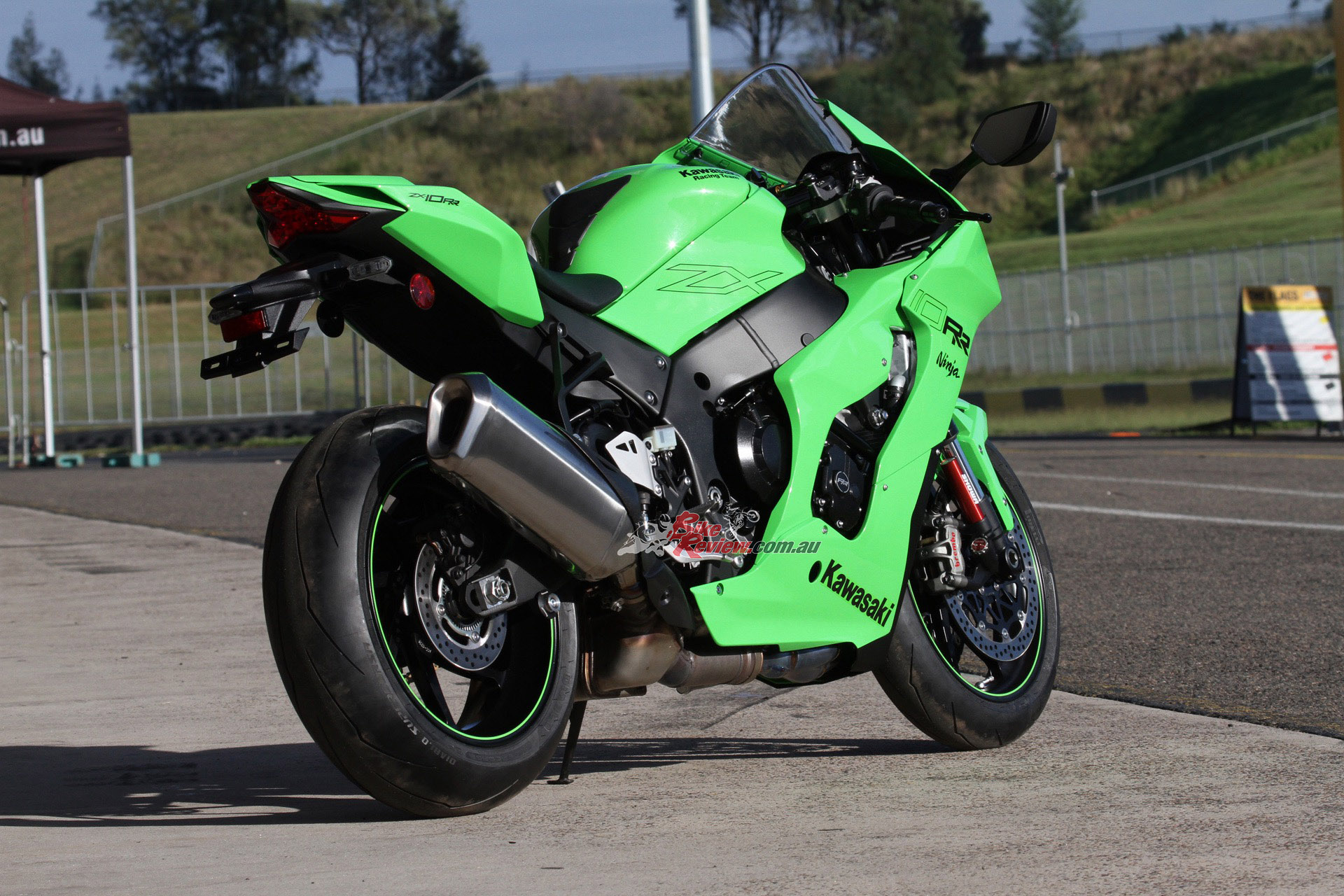
“Within a lap I am comfortable on the RR. Like with the 10R, I seem to fit well and really like the rider triangle.”
Within a lap I am comfortable on the RR. Like with the 10R, I seem to fit well and really like the rider triangle. I’m not getting a lot of feedback or grip from the SP tyres; despite the fact they are straight off 80ºC warmers. The KTRC is overactive and as I open the throttle gently at the apex of turn two of SMSP, I’m suddenly flung into the screen as the engine power is abruptly cut. This happens again in the T9 hairpin, so I enter the pits to check the electronics settings…
Switching from Sport Mode I jump into one of the four Rider Modes and set the power to max (F), KTRC to minimum (1) and I leave engine braking on Light. These are the actual Sport preset settings anyway, but I just wanted to make sure. A quick lap to test those settings results in a similar incident, so again, I pit and re-set things.
Read Jeff’s full test on the standard Kawasaki Ninja ZX-10R here…
This time KTRC minimum (1) again, Power medium (M), engine braking still Light. Again, a few dramas, so I try again – engine braking (KEBC) Off, KTRC Off, Power M and it is fantastic – no more sudden loss of power as the KTRC cuts in. I am now able to let the rear tyre move with some freedom.

“I’m soon in the low 1:40s and clipping apexes with pinpoint accuracy, hitting braking points with complete consistency and all while not working hard at all. I finish the day a few seconds faster.”
I do a full session and completely gel with the ZX-10RR. Once the SP’s come into their own and I have some confidence in them, I really go for it and despite having not track tested for over 12-months I feel like I have been on track regularly.

I tried Full power with the KTRC on 2 but ended up going back to no KRTC and no KEBC and found that to be best wth F power.
The 10R is making me look good and lap much faster than I ought to be. I’m soon in the low 1:40s and the bike is clipping apexes with accuracy, hitting braking points with complete consistency and all while not working me hard at all. I would go on to finish the day a few seconds faster.
The smooth delivery of power, high-end track ready suspension and sublime brakes, combined with the highly developed aero and ergonomics that WorldSBK domination and decades of superbike experience, which the Kawasaki factory have learned great things from, have truly come together in this masterpiece Ninja… The only thing I’m after now? More power, Sir! Medium is not cutting it.
“It’s so quick, yet so smooth, and having ridden some wild ZX-10Rs over the years, including as mentioned the WorldSBK, I can vouch for the power that this RR has”…
So, I head back in for a break and a cold drink then switch from medium to full power (F). Now we are talking. Unleashing all that horsepower, with the quick-revving nature of the homologation special engine, with KTRC and KEBC off, now that is what I call living… Thankfully, the engine character is so forgiving, being the softer of the inline fours in lower and middle range torque, with a smooth climb and 6000rpm followed by a hard hit from 8000rpm onwards, accessible via a slick quickshifter and gearbox.
So smooth in fact that the rear Pirelli Supercorsa SP, despite being a track day tyre and the equivalent to an older SC3, can predictably and safely hook up and drive the 10RR forward at blisteringly fast pace. It’s so quick, yet so smooth, and having ridden some wild ZX-10Rs over the years, including as mentioned the WorldSBK, I can vouch for the power that this RR has and only imagine what it could be like with a race exhaust system and some ECU work for full track use. Holy Moly!
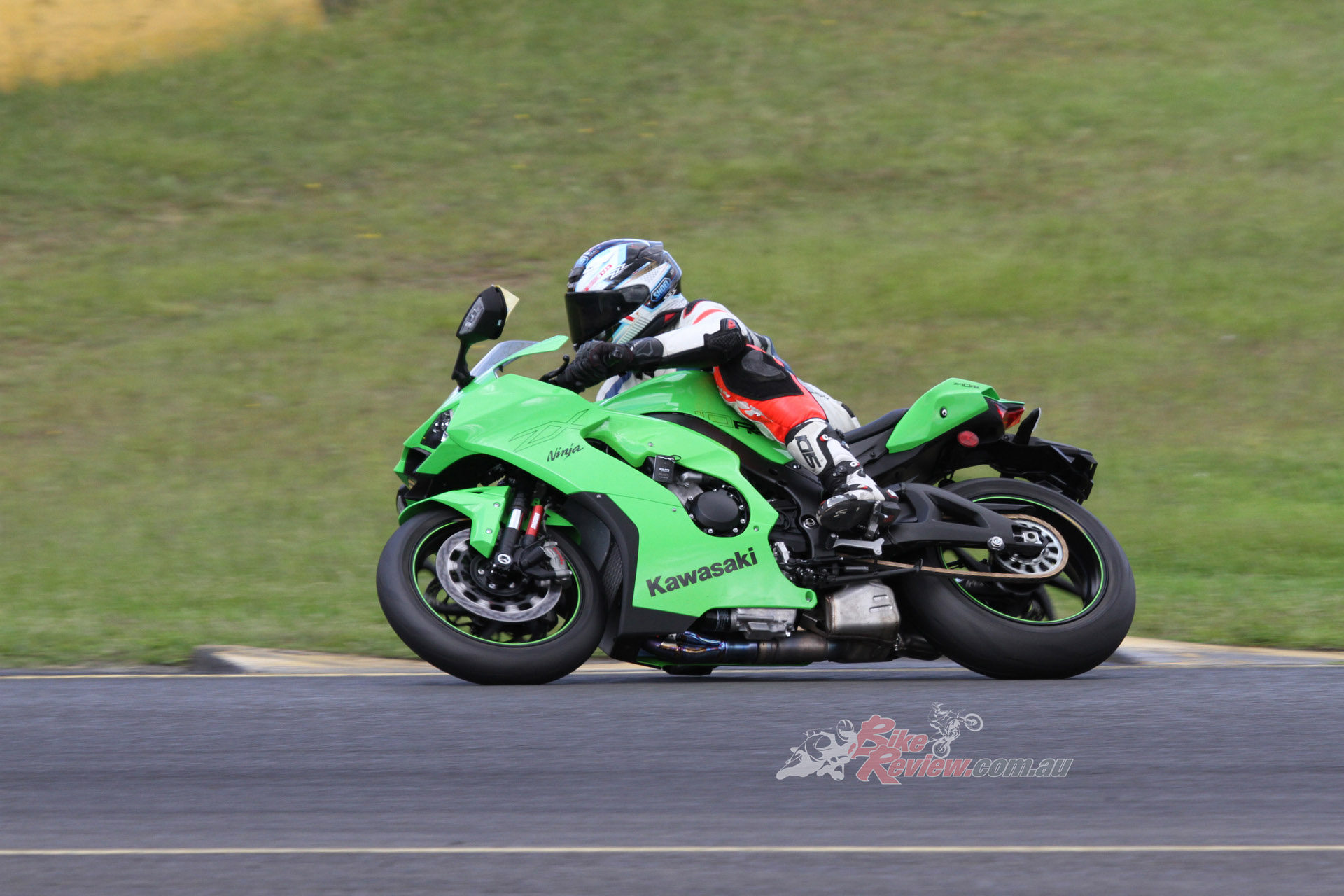
Compared to the standard ZX-10R, the RR feels lighter on direction change and is less tiring to ride, while accelerating harder and being faster up top yet easier in the middle.
Although I would have preferred to be taking advantage of the electronics more on the day, I had experienced those in detail the year before, and I do believe it may have had something to do with the SP rear tyre slip and the sensitive KTRC picking up on that.
“None other than Jonathan Rea himself is the only rider other than yours truly to ride this exact machine”…
If the bike had race tyres fitted, I’d say on the day that the electronics would have worked well with the extra grip, as none other than Jonathan Rea himself is the only rider other than yours truly to ride this exact machine and he had no issues with it at Phillip Island in his display laps, however, he was on slicks, so that backs up my thoughts on the tyre slip issue. The bike is designed for race rubber.
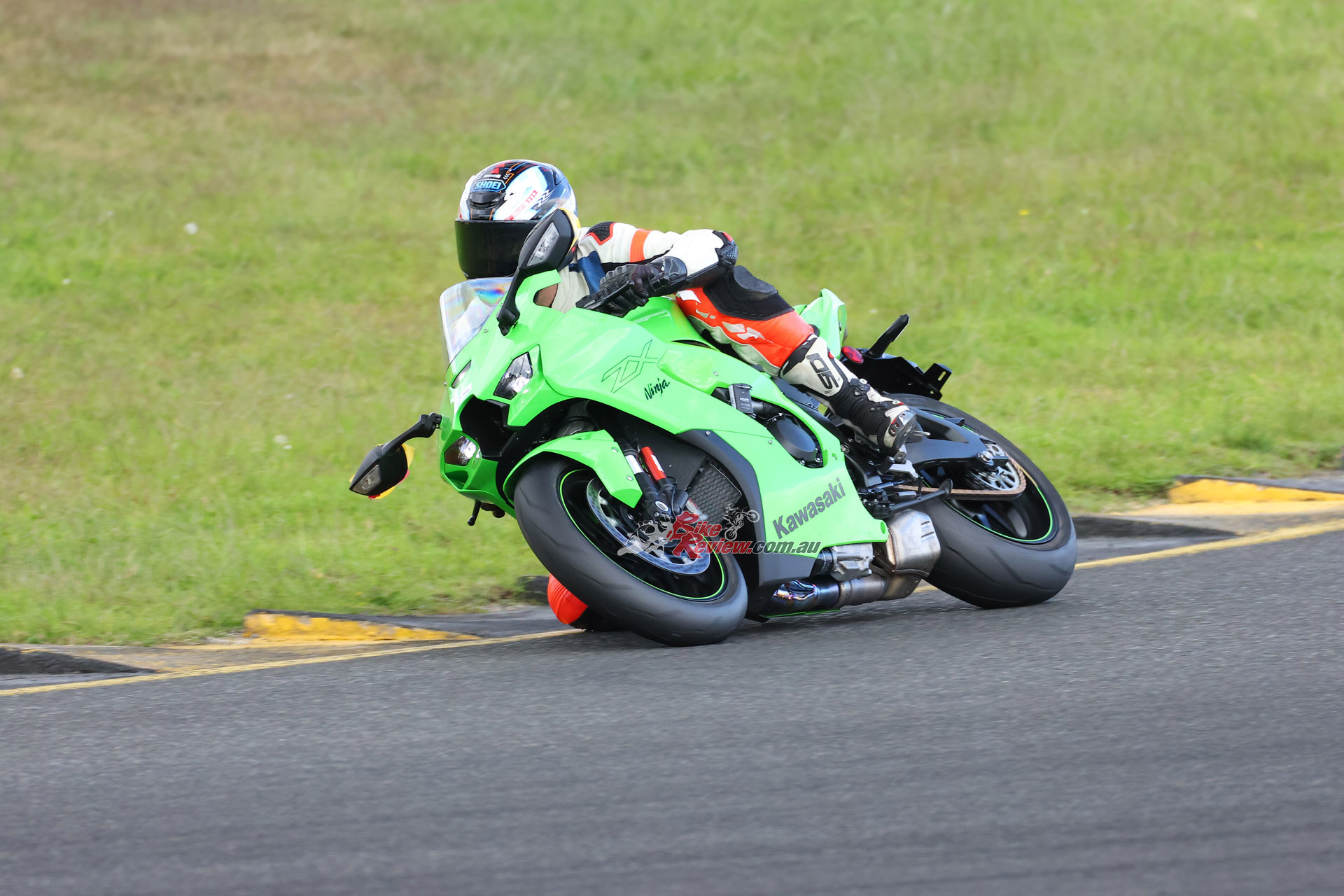
The chassis and geometry give intimate feedback and lots of confidence once the tyres are up to working temperature.
With sharp, stable and accurate steering on or off the amazing brakes, track ready fantastic suspension that did not need touching on the day as I lapped in the 1:39s in the last sessions on the treaded SP tyres, the ZX-10RR really is a special motorcycle and although not as wild as the 1990s RR models with their flat-slide carb’s and dry clutches, it is still a worthy collectable for those with the cash.
I lapped SMSP in the 1:39s in the last sessions on the treaded SP tyres…
It is a fantastic starting point for a racer with that very handy and expensive to chase additional 800rpm, and for ride day punters, it will make your track days a real pleasure being a refined bike that will help you not fight you around the circuit. On the road, it will still be fun but no advantage over the ZX-10R.
Compared to the ZX-10R, the ZX-10RR feels more flickable in direction changes, is less tiring to ride as a result, has a faster revving engine that is a more responsive and has a bigger top-end hit plus the extra rpm, which makes it faster up top.
For road riders that do the occasional track day, there isn’t an advantage I see over the standard ZX-10R, unless you have previous race experience or are riding quick lap times that mean you can make use of the thoroughbred nature of the beast. However, if you want something very rare, special and a definite future collectable and investment, go and grab one while you can. Park it in the living room!

Part with you your money if you’ve got it! The ZX-10RR will become a thing of mythical legend in years to come… a bit like the real Hulk superhero… I would ark mine in the living room if I had one…
Tech Talk
The 998cc, liquid-cooled, four-stroke, inline four, DOHC engine benefits from feedback based on the WorldSBK machine in the form of a new air-cooled oil cooler and cylinder-head changes, with the ZX-10RR high-lift cam ready. The new cooler means that oil is routed from the left lower crankcase to the oil cooler, then returned on the right side. The increased cooling performance contributes to engine performance at all rpm.
ZX-10R vs ZX-10RR Side By Side
The standout features of the limited production Ninja ZX-10RR (500 machines worldwide), are the lightweight pistons to complement its Titanium connecting rods, both designed by Pankl. A higher rev limit (400rpm more) further strengthens the powerhouse’s potential. It also has Marchesini forged alloy wheels, a single seat and stainless steel braided brake lines.
The Ninja ZX-10RR features special high-performance titanium connecting rods and lightweight pistons designed by Pankl, a company specialising in developing and manufacturing engine and drivetrain components for formula race cars, high performance vehicles and the aerospace industry. These high-performance parts, which contribute approximately 500g in weight savings, were developed specifically for the Ninja ZX-10RR.
In order to take full advantage of regulations in the Superbike World Championship, a number of engine changes increase the Ninja ZX-10RR’s rev limit to 14,700rpm. Raising the rev limit not only moves the powerband 500rpm higher, it enables an even wider powerband, contributing to improved response.
Designed with advanced aerodynamics, a new upper cowl with built-in winglets and compact headlights improves aerodynamic performance. Chassis geometry has been updated in order to improve upon the Ninja’s cornering performance. Suspension settings have been optimised to match. The swingarm pivot is 1mm lower, which enables better rear suspension action during corner exits.
A longer wheelbase (1440mm to 1450mm) care of a 2mm greater fork offset and an 8mm longer swingarm means more high-speed stability. The revised fork offset results in a shorter trail, which facilitates changing direction, especially in the off-throttle phase of the corner (after tip-in, before apex).
The Ninja ZX-10RR is supported by a sophisticated IMU-enhanced electronics package with traction control, an Ohlins steering damper, cornering ABS, launch control and a bi-directional quick-shifter. Integrated riding modes and electronic cruise control are just the ticket for road riding, as well as the full-colour TFT instrument screen with smartphone connectivity.
The twin-spar aluminium frame, high-grade fully adjustable SHOWA suspension and lightweight Marchesini wheels help to deliver stability, handling, and millimetre-precision cornering, with stopping expertise the best in the business thanks to Brembo M50 monobloc four-piston calipers.
The ZX-10RR has three pre-determined settings (Sport, Road, Rain) or four manual settings (Rider 1-4). In the manual Rider modes, each of the systems can be set independently. In addition to scrollable multifunction windows, two display modes offer a choice of how they want their information presented. Updates to Modes 4 and 5 (the most intrusive) result in a more rider friendly character that facilitates making throttle inputs mid-corner or on corner exits.
The LED headlights use direct projection units from Mitsubishi – the first use of their luminous optical modules on a motorcycle. The LED headlights are bright, compact and lightweight, weighing 1200g (compared to 1650g for the halogen units on the previous model).
The Ram Air intake – a Ninja supersport trademark – retains it’s shape from the 2021 update and the design of cowl directs air toward the intake so its efficiency is unchanged. Winglets built into the upper cowl generate downforce that helps keep the front wheel on the ground on corner exits and during strong acceleration. LED-type rear turn signals complete the all-LED lighting package for all markets while slots incorporated in the new tail cowl design contribute to the aerodynamic styling.
2022/2023 Kawasaki Ninja ZX-10RR Specifications
Price: $42,379 RRP + ORC. There are as of August only a small number left in Kawasaki Dealerships Nationally…
Warranty: Two-year, unlimited kilometre
Colours: Lime Green
Service: 1k then every 12k, valve clearance & spark plugs every 24k
Claimed power: 149.3kW[204hp]@14000rpm
Claimed torque: 111.8Nm[85ft-lbs]11700rpm
Wet weight: 207kg
Fuel consumption (measured over 500km): 6.2L/100km
Fuel capacity: 17L
Engine: Liquid-cooled, in-line four-cylinder, four-stroke, 16-valve, DOHC, 998cc, 13.0:1 compression, 76 x 55mm bore x stroke, four dual injection 47mm injectors, electronic throttle valves, S-KTRC, Ride Modes, KEBC, KLCM, KQS Gearbox: Six speed, cassette style Clutch: Wet, multi-disc back-torque limiting clutch.
Chassis: Cast aluminium twin spar frame, aluminium swingarm, Rake: 25, Trail: 106.7mm
Suspension: 43mm Showa BFF forks, external compression chamber, compression, rebound, preload adjustable, 120mm travel, Showa BFRC lite shock, compression, rebound, preload adjustable, horizontal Back-link, 115mm travel.
Brakes: (KIBS) Dual 330mm semi-floating Brembo front rotors, Brembo radial Monobloc four-piston M50 calipers, Brembo master-cylinder, 220mm rear rotor, Nissin single-bore pin-slide caliper
Wheels & Tyres: Marchesini forged alloy, 120/70 – 17, 190/55 – 17 Pirelli DIABLO Supercorsa SP tyres, Ohlins electronic steering damper,
Dimensions:
Wheelbase: 1450mm
Ground clearance: 135mm
Seat height: 835mm
Overall length: 2085mm
Overall width: 750mm
Overall height: 1185mm
Instruments & Electronics: 4.3in TFT display, Power Modes, S-KTRC (Sport Kawasaki TRaction Control), KQS (Kawasaki Quick Shifter), 6 axis IMU, KCMF (Kawasaki Cornering Management Function), electronic steering damper, (ECC) Cruise Control, (ERI) Economical Riding Indicator, KIBS (Kawasaki Intelligent Braking System), KLCM (Kawasaki Launch Control), EBC (Engine Brake Control), BT connectivity via RIDEOLOGY THE APP.
Editor’s Note: If you are reading this article on any website other than BikeReview.com.au, please report it to BikeReview via our contact page, as it has been stolen or re-published without authority.
KAWASAKI NINJA ZX-10RR GALLERY
The Verdict | Track Test: Kawasaki Ninja ZX-10RR Homologation Special

